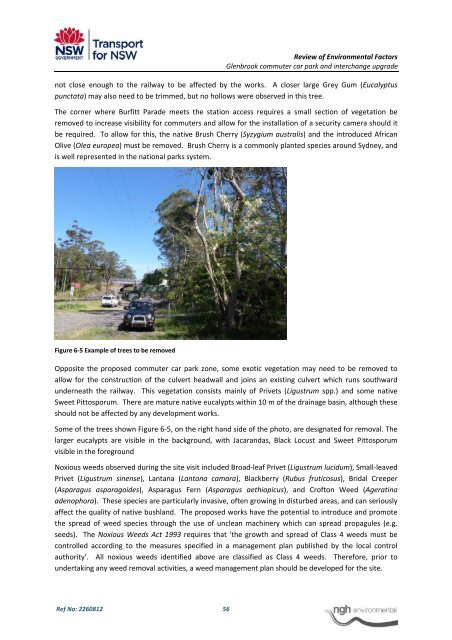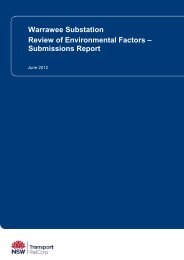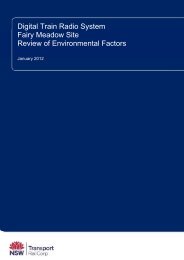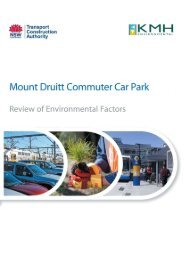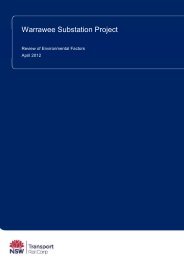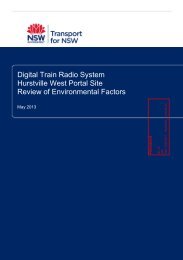Review of Environmental Factors<strong>Glenbrook</strong> commuter car park and interchange upgrade• invasion and establishment of exotic vines and scramblers, exotic perennial grasses,Lantana (Lantana camara), African Olive (Olea europaea), and• the removal of dead wood and dead trees.Without mitigation methods, all of these processes have the potential to be exacerbated by the works onsite. By minimising the removal and disturbance of native living and dead vegetation as well as bushrock,these threatening processes can be beneficially reduced. There would necessarily be some disturbance tothe native vegetation of the site during the works, which can aid the spread of exotic weeds such asLantana and African Olive, both of which were observed on site. Works may include the disturbance oralteration of bushrocks around the site, which can modify the habitat available <strong>for</strong> reptiles.FloraConsistent with the <strong>Transport</strong> <strong>for</strong> <strong>NSW</strong> Vegetation Offset Guide (Draft 2012b), an Avoid, Minimise, Offsetapproach has been taken to the design and implementation of the project. The most substantial impacton vegetation that is proposed <strong>for</strong> the site is the removal of nine trees in the zone designated <strong>for</strong> theproposed commuter car park. These trees consist of Sydney Blue Gum (Eucalyptus saligna), SweetPittosporum (Pittosporum undulatum), Black Locust (Robinia pseudoacacia) and Jacaranda (Jacarandamimosifolia) (Figure 6‐5). The latter two species are introduced non‐native trees and their removal willhave no ecological impact. The native species (Sydney Blue Gum and Sweet Pittosporum) being removedare both widespread and well‐conserved within nearby national parks and reserves, and their removalwould not significantly impact the flora of the region. Trees that are not being removed may still beimpacted by the works, due to a potentially shallow root system. Sydney Blue Gum does not have ataproot, but develops roots throughout the soil profile. On shallow soils, or soils that do not dry outoften, the root system can be largely focused in the upper 60 cm of soil. On deeper soils, or soils whereperiodic drying occurs, the shallow roots die off and a more stable, deeper root system develops.Heading east along Burfitt Parade, vegetation inside the rail corridor from the station entrance to theDDA spaces would be removed in order to widen the pavement. These sites would require the removal ordisturbance of small areas vegetation, most of which consists of native shrubs and small trees. Speciespresent include Sydney Golden Wattle (Acacia longifolia), Parramatta Wattle (Acacia parramattensis),Black Wattle (Acacia mearnsii), and Needlebush (Hakea sericea). Some native and exotic groundcoversare also present in the area, as well as smaller native herbs. None of the species observed during thesurvey are threatened, and all are well represented in the nearby bushland.A lot of the vegetation mentioned above <strong>for</strong>ms a patchy mosaic of living, dead and dying plants that runsfrom the entrance of the proposed commuter car park to well past the station entrance. This vegetationwould be removed and replaced, details of which are provided in the Landscape Concept Plan inAppendix B. This vegetation was not fully surveyed due to the dangerous rock face near the stationentrance. However, no threatened species were observed, and it is unlikely that any threatened speciesare present.For the proposed adjustment of the 11 KV overhead line from the north side of the tracks to the southside, there would need to be some tree removal and trimming. The species involved are mainly SweetPittosporum, Jacaranda, and smaller groundcovers such as Bracken Fern (Pteridium esculentum) and anumber of native and introduced grasses. Some larger mature eucalypts approximately 10‐15 m into thebushland on this side of the railway are good quality habitat trees and a number of hollows wereobserved. While the exact location of the overhead line has not been decided, these trees are probablyRef No: 2260812 55
Review of Environmental Factors<strong>Glenbrook</strong> commuter car park and interchange upgradenot close enough to the railway to be affected by the works. A closer large Grey Gum (Eucalyptuspunctata) may also need to be trimmed, but no hollows were observed in this tree.The corner where Burfitt Parade meets the station access requires a small section of vegetation beremoved to increase visibility <strong>for</strong> commuters and allow <strong>for</strong> the installation of a security camera should itbe required. To allow <strong>for</strong> this, the native Brush Cherry (Syzygium australis) and the introduced AfricanOlive (Olea europea) must be removed. Brush Cherry is a commonly planted species around Sydney, andis well represented in the national parks system.Figure 6‐5 Example of trees to be removedOpposite the proposed commuter car park zone, some exotic vegetation may need to be removed toallow <strong>for</strong> the construction of the culvert headwall and joins an existing culvert which runs southwardunderneath the railway. This vegetation consists mainly of Privets (Ligustrum spp.) and some nativeSweet Pittosporum. There are mature native eucalypts within 10 m of the drainage basin, although theseshould not be affected by any development works.Some of the trees shown Figure 6‐5, on the right hand side of the photo, are designated <strong>for</strong> removal. Thelarger eucalypts are visible in the background, with Jacarandas, Black Locust and Sweet Pittosporumvisible in the <strong>for</strong>egroundNoxious weeds observed during the site visit included Broad‐leaf Privet (Ligustrum lucidum), Small‐leavedPrivet (Ligustrum sinense), Lantana (Lantana camara), Blackberry (Rubus fruticosus), Bridal Creeper(Asparagus asparagoides), Asparagus Fern (Asparagus aethiopicus), and Crofton Weed (Ageratinaadenophora). These species are particularly invasive, often growing in disturbed areas, and can seriouslyaffect the quality of native bushland. The proposed works have the potential to introduce and promotethe spread of weed species through the use of unclean machinery which can spread propagules (e.g.seeds). The Noxious Weeds Act 1993 requires that 'the growth and spread of Class 4 weeds must becontrolled according to the measures specified in a management plan published by the local controlauthority'. All noxious weeds identified above are classified as Class 4 weeds. There<strong>for</strong>e, prior toundertaking any weed removal activities, a weed management plan should be developed <strong>for</strong> the site.Ref No: 2260812 56


